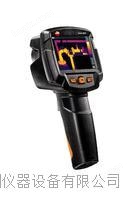Testo 868 手持式红外热成像仪
产品简介
详细信息
订货号:
产品描述
testo 868热像仪可以让工作更加快速方便——专业的热成像质量。您可以使用其便捷的功能生成无差错和客观可比的红外图像。借助IFOV警示器,?-Assist(发射率辅助)以及ScaleAssist(温标辅助)功能,不仅可以帮助您避免测量误差,并且还可以针对建筑热成像合理的设置发射率(?)和反射温度(RTC),以及对对比度进行合理设置。
智能和联网的testo 868热像仪
testo 868热像仪可以通过WLAN确保与您移动终端设备之间的无线通信。借助在iOS和安卓操作系统下运行的德图热成像App,您可以直接在现场编写和发送报告以及在线对其进行保存。此外,您还可以使用智能手机或平板电脑作为显示器或者进行远程控制。
testo 868热像仪的应用领域
testo 868热像仪可用于检测泄露,发现过热点,定位热桥,以及检测结构缺陷,它专门为相关行业日常维护和安装工作而开发。当您需要检测缺陷和进行维护时,它可以帮助您快速而可靠地工作。
testo 868热像仪的技术亮点
令人印象深刻的热成像技术,操作非常简单,testo 868热像仪具有以下特点:
高分辨率,因而图像质量高:19,200个温度测量点,以确保的热成像。160 x 120像素的红外分辨率——德图Super红外超像素技术,可实现320 x 240像素的红外分辨率
可辨别0.10℃以上的温差
德图的热成像App可以让您在现场撰写、在线保存以及通过电子邮件发送报告,并让您可以使用移动终端设备作为显示屏或进行远程控制。
内置可见光数码相机可以与热成像同时生成一个真实图像
自动辨识冷热点,并直接显示临界温度条件
德图的ScaleAssist(刻度辅助)功能可自动设置刻度,可以生成客观、可比和误差较小的热图像,比如建筑的热绝缘
德图的?-Assist(发射率辅助)功能可以通过自动确定和设置发射率和反射温度,确保正确的测量结果
IFOV警示器功能可自动确定与被测物体之间的距离或测量点尺寸,并且测量点会显示在热图像上——可以避免测量误差
在PC上进行图像评估的专业软件
可以选择将热图像保存为JPEG格式
产品包含
testo 868热像仪内置蓝牙/WLAN无线模块,USB电缆,充电器,锂电池,专业软件安装光盘,3个德图ε-标签,说明书,校准证书以及仪器箱。
技术数据:
红外图像输出
对焦: 定焦
红外分辨率: 160 ×120 像素
图像刷新频率: 9 Hz
红外超像素 (空间分辨率): 2.1 毫弧度
红外超像素(像素): 320 x 240 像素
几何分辨率 (IFOV): 3.4 毫弧度
zui小聚焦距离: <0.5 m
视场: 31° x 23°
热灵敏度: 100 mK
光谱范围: 7.5 ~ 14 μm
可见光图像输出
zui小聚焦距离: 0.5 m
图像像素: zui低310万像素
图像显示
显示屏选项: 红外图像/可见光图像
颜色: 4种
显示屏类型: 3.5英寸液晶显示屏幕,分辨率320X240
测量
反射温度: 手动
ε-Assist: ?
测量范围: -30 … +100 ℃; 0 ... +650℃
精度: 某段量程内有效+ 宽容度 ±2 ℃, ±2 % 读数(较高数值适用)
发射率: 0.01 ~ 1
测量功能
分析功能: 平均点的测量,热点/冷点识别,时间增量
模块附件: ?
空间分辨率: ?
图像设备
数码相机: ?
全屏模式: ?
JPEG存储: ?
视频流: 支持 USB, 支持无线红外App
标准镜头: 31° x 23°
界面: USB 2.0 Micro B型接口
无线局域网络连接: 连接德图红外热像仪app 无线应用模块 WLAN通信(欧盟、EFTA、美国、AUS、CDN,TR)
图像存储
图像格式: .bmt; 可保存为.bmp; .png; .csv; .xls; .jpg
存储设备: 2.8GB 内存
电源
电池类型: 快速充电器
操作时间: 4 小时
交流电供电: 是
环境情况
外壳防护等级: IP54
振动: 2G
环境湿度: 20 - 80 %RH ,不结露
储存温度: -30 ~ +60 ℃
操作温度: -15 ~ +50 ℃
物理规格
外壳: PC - ABS
重量: 510 g
大小: 219 x 96 x 95 mm
PC软件
系统要求: Windows 10; Windows 8; Windows 7
红外热像仪标准/保修
EU-/EG-法规: EMC: 2014/30/欧标; RED: 2014/53/欧标
技术参数
Product colour: Black
显示屏背光灯: bright / normal / dark
应用故事:
Detecting structural defects and ensuring building quality (also for images of the building shell)
Analysis with the Testo thermal imager is a fast and efficient method of detecting possible structural defects. Furthermore, the thermal imager is also ideally suited for providing proof of the quality and correct implementation of construction measures. Any heat losses, humidity and lack of air tightness arising in a building are visible in the thermal image. The Testo thermal imager offers the possibility of detecting structural damage and implementation defects in the thermal insulation – all using a non-contact method! The testo ScaleAssist function, which automatically ensures optimum setting of the thermal image scale, means you get objectively comparable thermal images of buildings. This makes correct assessment of structural defects and thermal bridges easier than ever before. Detecting insulation defects and thermal bridges in the building shell is one of the typical applications.
Thermal imager testo 871 - Detecting structural defects and ensuring building quality
Carrying out detailed energy consultancy
In building thermography, infrared technology is ideally suited for the fast and effective analysis of energy losses in the heating or air conditioning of buildings. Thanks to its high temperature resolution, the thermal imager provides detailed images of inadequate insulation and thermal bridges. It is impressive in terms of recording and documenting energy losses on outer windows and doors, roller blind casings, radiator niches, roof constructions or the entire building shell. The thermal imager is the best measuring instrument for comprehensive diagnostic and maintenance uses and always a good choice when it comes to energy consultancy.
Thermal imager testo 872 - Energy consultancy
Easy checking of heating systems and installations
Heating, ventilation and air conditioning systems can be quickly and reliably checked thanks to the easy and intuitive operation of the Testo thermal imager. Just a quick look with the thermal imager is enough to discover irregularities in temperature distribution. Thermography can therefore be used to easily locate clogged radiators and leaks.
Typical applications for the thermal imager:
Pinpointing the course of heating loops in an underfloor heating system
Checking radiators for silting
Measuring the flow and return temperature
Thermal imager testo 871 - Checking of heating systems and installations
Investigating moisture damage
Not every damp wall is caused by a faulty water pipe. Water can rise or penetrate due to faulty installation of rain and water run-off systems, causing wet walls. Moisture damage can also occur due to blocked drains or insufficient seepage. The thermal imager finds the cause of rising damp or penetrating rainwater straight away, thus preventing greater damage.
Thermal imager testo 871 - Investigating moisture damage
On the trail of a ruptured pipe
If a pipe rupture is suspected, the only solution left is often to break open entire wall or flooring areas. The thermal imager enables you to minimize damage and reduce costs, because you locate precise leaks in underfloor heating and other inaccessible pipelines. This avoids opening up walls and floors unnecessarily and considerably reduces the repair costs.

